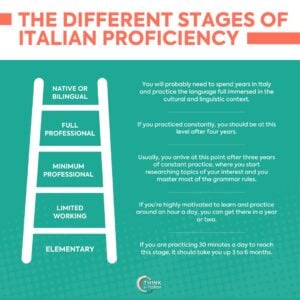What da and per mean in Italian?
Have a look at the examples below:
Da quanto tempo vivi in Italia?
How long have you been living in Italy?
Oggi ho parlato italiano per due ore.
Today I spoke Italian for two hours.
As you could see, da and per are prepositions. So let’s take a closer look at the two prepositions separately to learn when to use which one correctly.
How to use da with expressions of time?
In Italian, we use the preposition da, when we want to talk about how long we have been doing something for.
In English, da can be translated as since:
Da quanto tempo.
Since how long.
With the construction da quanto tempo, Italians just use the present simple, unlike in English, so it is even easier!
Da quanto tempo sei sposato?
How long have you been married for? (Since how much time have you been married?)
To answer this, you will simply need to use the preposition da followed by the amount of time:
Sono sposato da 3 anni.
I have been married for 3 years.
Vivo in Italia da 2 mesi.
I have been living in Italy for 2 months.
Da is always used to describe an action that started in the past and is continuing up to the time of speaking.
How to use per with expressions of time?
Per, on the other hand, translates as for and it indicates how long you did something for in the past or how long you will be doing something for in the future.
Ho studiato Italiano per 2 anni quando ero piccolo.
I studied Italian for 2 years when I was a child.
Domani dovrò lavorare per 3 ore.
I will have to work for 3 hours tomorrow.
As you can see, we use per with the past or future tense. If we use it with the present tense, we are talking about a habitual action.
Parlo in italiano per ore tutti i giorni.
I speak Italian for hours every day.
Practice with Quizlet
Here's a set of flashcards and quizzes to practice this grammar topic.What is the difference between per and da?
What is the difference between per and da in a sentence that talks about time?
Let’s have a look at the examples below:
Sto aspettando da 10 minuti.
I have been waiting for 10 minutes.
Ho aspettato per 10 minuti.
I waited for 10 minutes.
As you can probably get from the English translation, the first example is in the present (I am still waiting) while the second example is in the past (I am not waiting anymore).
Let’s see an example in the future tense:
Quando arrivi avrò iniziato a lavorare da 3 ore.
When you arrive I will have been working for 3 hours.
Quando arrivi avrò lavorato per 3 ore.
When you arrive I will have worked for 3 hours.
In the first example, I will still be working when you arrive and will probably continue. In the second, I will have already worked for 3 hours and finished.



















